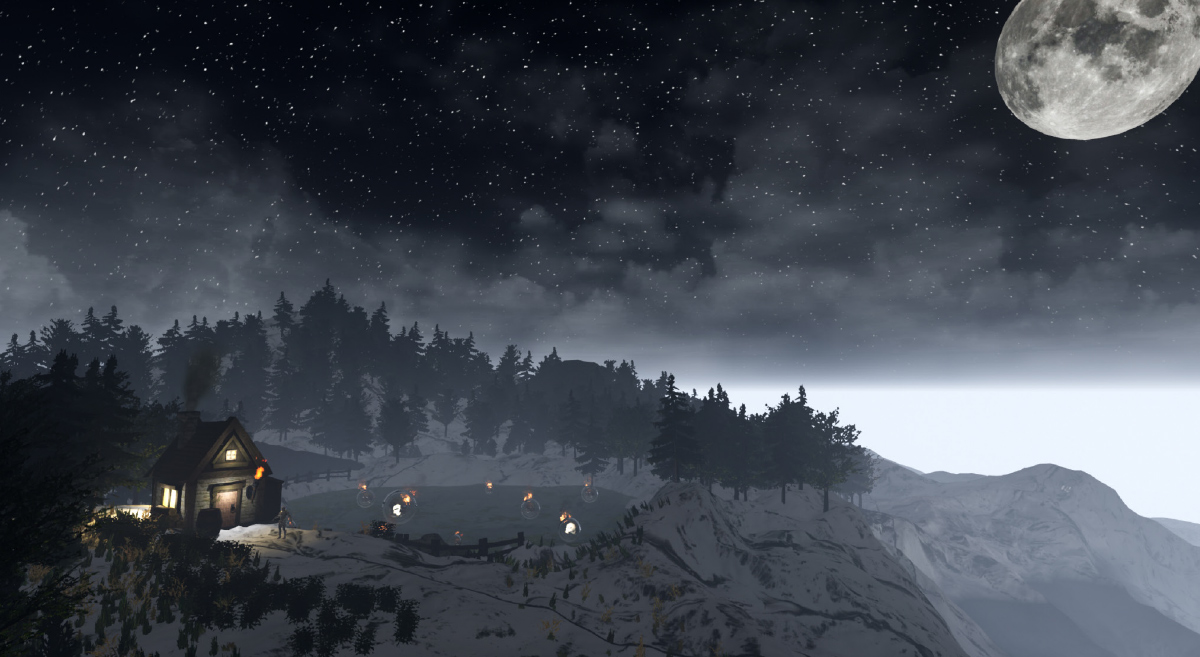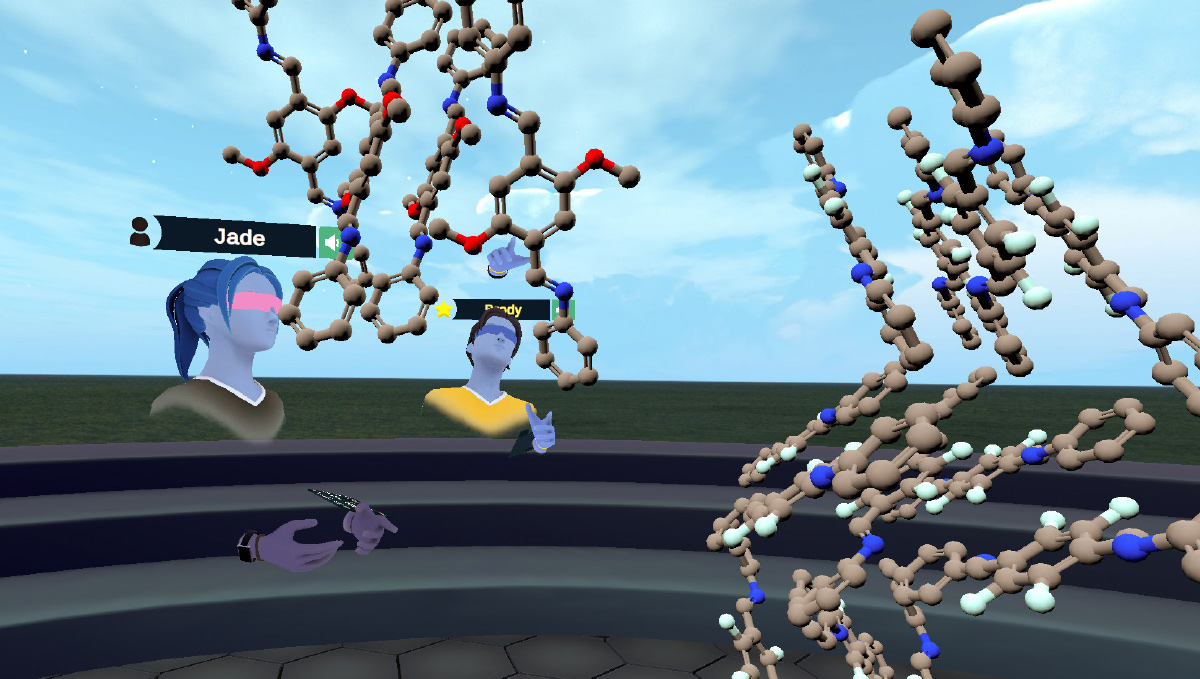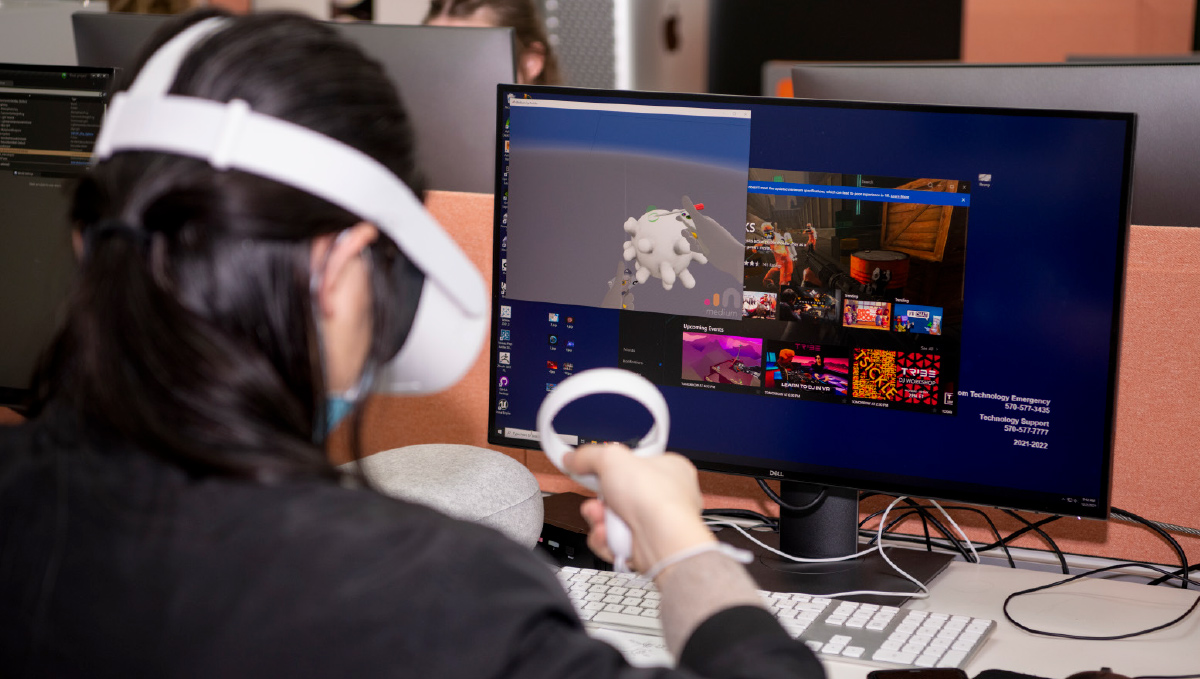
ivil & Environmental Engineering Professor Ron Ziemian stepped inside Bucknell’s Academic East before a single shovel had pierced the ground on which the building would sit.
A 78,000-square-foot innovation hub, Academic East opened in 2019. It houses a spacious human motion lab for biomedical research, top-of-the-line scanning electron microscopes and multifunctional spaces for senior engineering design — as well as high-tech classrooms and offices for the Department of Education.
Ziemian got to preview it all in the three-dimensional world of virtual reality (VR).
“As an associate dean in the College of Engineering at the time, I’d been given access to VR renderings of Academic East before construction began,” he says. “It provided an incredibly realistic feeling for what to expect when the structure was done. Actually, it was very strange to come back and walk the building in real life for the first time — I had this déjà vu feeling that I’d been there before.”
That was one of Ziemian’s first glimpses into the wonders of virtual technology in engineering, architecture and construction — but it wouldn’t be the last. As one of several professors experimenting with VR in Bucknell classrooms, Ziemian is now using the futuristic medium to expand learning possibilities for the aspiring engineers he instructs.
An evening lab for his spring Design of Steel Structures course transported 15 students from a computer lab in Bucknell’s newly erected Holmes Hall to the 52nd story of a Chicago high-rise construction at midday; then inside the immense, product-filled warehouses of the High Steel fabrication plant in Lancaster, Pa.; and, finally, to the melt shop floor at the Nucor-Yamato Steel Company in Blytheville, Ark.
Equipped with Oculus Quest headsets and a pair of handheld controllers, students experienced riding a crane as it hauled soon-to-be-recycled metal from a scrapyard, standing mere feet away from a volcanic metal-melting furnace and watching steelworkers weld girders in real time — all via immersive 360-degree video streamed through the Oculus.
Widely used in video gaming, these headsets combine surround sound, split-picture imaging and head motion sensors to immerse the wearer in thrilling simulations.
The module “would have been impossible to replicate through normal classroom instruction,” says Tyler Hagerup ’23, a civil engineering major from State College, Pa. “It was amazing seeing how so many different civil engineering concepts come together to build a skyscraper. The VR headset allowed me to visualize everything I’ve been taught during my past three years.”

Creative Capabilities
Ziemian drew inspiration from a professor at the University of Wisconsin-Madison who had collaborated with the American Institute of Steel Construction to produce the 360-degree video within the Chicago skyscraper. Then he went hunting for the equipment he needed to get his students 52 stories high without leaving campus.
Along the way, he found Professor Joe Meiser, studio art, who had already begun incorporating VR headsets into Bucknell’s art department curriculum and was happy to share his hardware.
“I’d been experimenting with it over the past three to four years in personal projects,” says Meiser, who specializes in sculpture and teaches an art fabrication course utilizing 3D printing. “There are also a number of artists in the field who are venturing into the virtual medium, which has been interesting to follow.”
Those creatives include pop artist Jeff Koons and Icelandic-Danish sculptor Olafur Eliasson, who have developed mesmerizing virtual experiences in partnership with Acute Art, a digital platform that allows artists to translate their works into new, augmented realities.
Meiser’s course, Digital Sculpture 2, invited Bucknell students to compose their own dynamic environments and virtual installations that could be explored through the Oculus. An early exercise employed ZBrush, a computer-aided design software, to render sculptural representations of “the grotesque.” Another placed students in artistic dialogue with contemporary sculptors as they molded large-scale installations for a virtual sculpture park.
The assignments not only encouraged the exploration of aesthetic experiences but of emotional ones too.
Taking full advantage of the world-building capabilities of VR, Ethan Sales ’22 mined the philosophical tension between fate and self-determination in the course’s penultimate project — an interactive space meant to provoke reflection on a societal conundrum.
Isolated on an island within Sales’ virtual world, the user rolls a dice and proceeds up a long, sunlit staircase to then be sequestered into one of three rooms: a lonely jail cell, a white-collar office filled with paperwork or a serene dining room with a table set for a fancy meal.
“The lower your number on the dice, the more stressful your situation. Much like real life, the luck of the draw can heavily affect how you proceed,” explains Sales, who came to Bucknell as a computer engineering major but later chose to pursue a degree in studio art. “The amazing thing about using VR as an artistic medium is that you can make unique environments at a scale that you just can’t do in reality unless you’ve got a million-dollar budget.
“Not everyone can do Anish Kappor-scale sculpture or produce giant, spiral towers like Louise Bourgeois,” Sales adds. “But in VR, anything is possible.”

Inside the Molecule
“As a materials scientist, a lot of what I do is think about molecules — their shape, their patterns and how they fit together,” Smith says. “It’s something that’s often hard to conceptualize because it all occurs on such a small scale.”
At the center of Smith’s work are complex structures called covalent organic frameworks (COFs), a class of crystalline materials that exist in both two-dimensional and three-dimensional forms. While the former is well understood, three-dimensional COFs are interlaced and hollowed, making the conditions of their formations and behavior more enigmatic.
The gamut of chemistry visualization software is “pretty good, but still has the constraints of a flat screen,” says Jade Gregg ’24, who conducts research with Smith as a Presidential Fellow. “So you lose a lot of dimensionality of structures like COFs when simply viewing it on a computer.”
Enter Nanome, a VR-based molecular modeling program that not only allows users to build chemical structures but also interact with them in a virtual environment. Gregg spent her first semester at Bucknell exploring the program’s vast range of features — from tools for calculating the angles of chemical bonds to a database of life-size molecules that can be loaded into the virtual environment. Then, in spring 2021, she helped Smith introduce the modeling software into his upper-level inorganic chemistry course.
“Communicating three-dimensional volume is always a challenge when teaching chemistry, but the depth perception of VR is game-changing,” Smith says. “It gives students a real, tangible sense of size and scope that you just don’t get when looking at drawings of compounds on paper or rotating models in your hands. It’s like the molecule comes alive in VR.”
The ability to manipulate molecular renderings has also proven transformative for Smith’s research, in which he and his cohort of undergraduate partners are untangling the complexities of how three-dimensional COFs are formed and structured. Because they’re porous, the crystalline solids carry great potential for use in water treatment and purification — if they can be mass produced and designed to attract multiple contaminants at once.
“The dream is this chemical compound that water can flow through, and it’s designed to grab lead, and then mercury, and then chlorine. But this layered, systematic functionality just doesn’t exist yet,” Smith says. “There are fundamental questions that have yet to be answered about how we design this kind of complexity into a material.”
“That’s where VR is incredibly useful,” Gregg says, “because we can learn things about these compounds that we might not have without this interactive technology” — like the fact that COFs are flexible, which Smith’s team was able to analyze in Nanome.
“I’m excited to see how much more we can do as we continue to experiment,” Gregg adds. “I feel like the sky’s the limit.”
The Future Frontier
“I can easily imagine using this technology to transport students to construction sites all over the world to view structures up close and identify safety concerns. But we’re not there yet,” Ziemian says. “The VR experience my students had was definitely good, but it wasn’t developed to the extent that it could be. What we’ll get as technology progresses is sure to have a major impact on how we educate our students.”
Accessibility is another hurdle to conquer. A top-of-the-line Oculus, for instance, is priced at $399 (controllers and charging accessories included). For a single class of 15 students, that’s roughly a $6,000 investment.

Bucknell is among the first crop of universities moving to permanently integrate VR into curricula across varying disciplines, joining schools like the University of Wisconsin, the University of Michigan, Morehouse College and South Dakota State. The latter institutions are two of 10 colleges planning to launch virtual “metaversities” to mirror their in-person campuses.
It’s a revolutionary landscape that intrigues forward-thinkers like Meiser, who’s investigating the potential of Facebook’s cutting-edge VR world-builders as platforms for collaborative learning. Together with Presidential Fellow Yuki Yao ’25, an economics major from Tokyo, Meiser is workshopping the creation of a virtual classroom, where students can work with peers on virtual projects in real time.
“It’s been posited that the emergence of the metaverse is going to be as important as the birth of the internet, just as the development of 3D printing will be as important as the industrial revolution,” Meiser says. “If those statements prove true, who knows what the world of the future will have in store for us.”